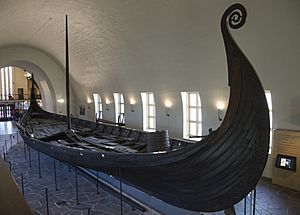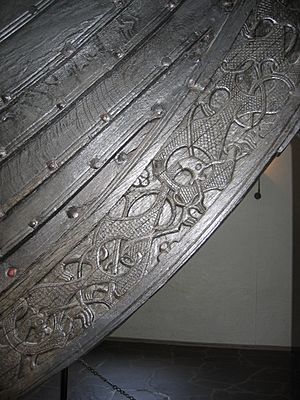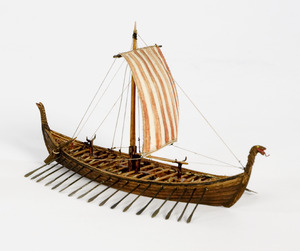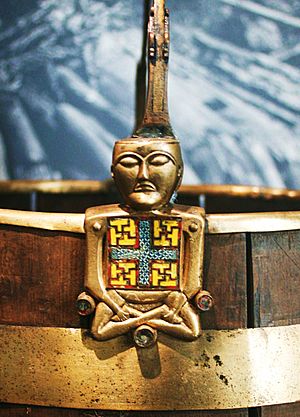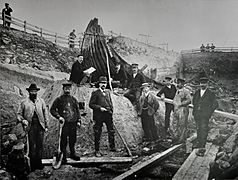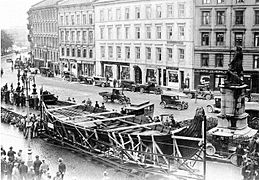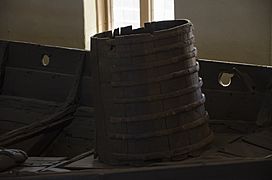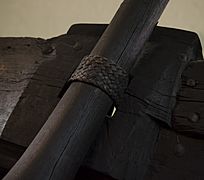Oseberg Ship facts for kids
The Oseberg ship is a famous Viking ship found in a large burial mound in Norway. It was discovered at the Oseberg farm near Tønsberg in Vestfold county. Many people consider this ship one of the most amazing objects from the Viking Age. Today, you can see the ship and some of its treasures at the Viking Ship Museum in Oslo, Norway.
Swedish archaeologist Gabriel Gustafson and Norwegian archaeologist Haakon Shetelig dug up the ship between 1904 and 1905. The burial mound was called Oseberghaugen. Inside the grave, they found the skeletons of two women. They also found many other items, known as grave goods. Scientists believe the ship was buried around 834 AD. Some parts of the ship are even older, dating back to 800 AD or earlier.
Contents
Ship's Design and Features
The Oseberg ship is a type of Viking ship called a Karve. It was built using a method called clinker built, where wooden planks overlap. The ship is made almost entirely of oak wood. It is about 21.58 meters (70 feet) long and 5.10 meters (16.7 feet) wide. The mast was about 9 to 10 meters (30 to 33 feet) tall.
With its large sail, the ship could reach speeds of up to 10 knots (about 18.5 km/h or 11.5 mph). The ship has 15 pairs of openings for oars. This means up to 30 people could row it at once. It also had a wide steering oar, an iron anchor, and a gangplank. The front (bow) and back (stern) of the ship are beautifully carved. These carvings show complex designs of "gripping beasts," a style known as the Oseberg style.
Experts have made very detailed photos and laser scans of the ship. This was done to see if the ship could be moved to a new museum. These scans helped them understand the ship's structure without causing damage.
Building a Replica Ship
In 2004, people started trying to build a copy of the Oseberg ship. Builders, scientists, and volunteers from Norway and Denmark worked together. They used the detailed photos and laser scans to help them. During this project, they found something important. The original ship had been slightly changed during its first restoration. Some beams had been broken.
This new discovery helped explain why an earlier copy of the ship, called 'Dronningen', had sunk. The builders of 'Dronningen' didn't know about the changes to the original ship. In 2010, a new project called Saga Oseberg began. This time, they used wood from Denmark and Norway. They also used traditional Viking Age building methods.
The new Saga Oseberg ship was finished and launched in Tønsberg on June 20, 2012. The ship floated very well. In March 2014, it sailed on the open sea. It reached a speed of 10 knots under full sail. This successful copy showed that the Oseberg ship could indeed sail. It was not just a burial chamber on land.
The People Buried in the Ship
The skeletons of two women were found in the ship's grave. One woman was likely around 80 years old. She had severe arthritis. She also had a condition that might have given her a more masculine look. The second woman was first thought to be 25–30 years old. Later tests suggested she was older, about 50–55.
It is not clear which woman was more important. We also don't know if one was sacrificed to join the other in death. The younger woman had a broken collarbone. At first, people thought this meant she was a human sacrifice. But closer checks showed the bone had been healing for several weeks. The rich burial and valuable items suggest this was a very important burial.
One woman wore a beautiful red wool dress. It had a special pattern and a fine white linen veil. The other woman wore a simpler blue wool dress with a wool veil. This might show that they had different social standings. Neither woman wore clothes made entirely of silk. However, small silk strips were sewn onto a tunic under the red dress.
Scientists studied the wood in the grave. They found that the burial happened in the autumn of 834 AD. The identity of the high-ranking woman is unknown. Some people think she might be Queen Åsa. She was the mother of Halfdan the Black and grandmother of Harald Fairhair. Recent tests suggest the women lived in Agder, Norway, where Queen Åsa also lived. However, this idea is debated. Some think she might have been a shaman, a type of spiritual leader.
Besides the women, the skeletons of 14 horses, an ox, and three dogs were also found on the ship.
Scientists tried to study the DNA from the younger woman. They found signs that she might have come from the Black Sea area, possibly Iran. However, later studies could not confirm these results. It is likely that the bone samples do not have much original DNA. They might also have been contaminated.
More studies of the skeletons showed interesting details about their lives. The younger woman's teeth showed she used a metal toothpick. This was a rare luxury in the 9th century. Both women ate a lot of meat. This was also a luxury, as most Vikings ate fish. However, there was not enough DNA to tell if the women were related. The two women were found together in one bed.
Treasures from the Grave
The grave had been disturbed a long time ago. Objects made of precious metals were missing. Still, many everyday items and artifacts were found during the 1904–1905 excavations. These included four beautifully decorated sleighs. There was also a richly carved four-wheel wooden cart. Bed-posts and wooden chests were found too.
One special item is called the "Buddha bucket" (Buddha-bøtte). It's a bucket handle made of brass and cloisonné enamel. The handle is shaped like a figure sitting with crossed legs. This figure has been compared to images of the Buddha. However, any real connection is uncertain. The patterned enamel on the figure looks more like human figures found in old Irish books, like the Book of Durrow.
More common items were also found, such as farm tools and household items. Many textiles were discovered, including wool clothes, imported silks, and narrow tapestries. The Oseberg burial is one of the few places where we find Viking Age textiles. The wooden cart is the only complete Viking Age cart ever found. A bedpost shows a rare example of a symbol called the valknut.
Keeping the wooden artifacts safe is a big challenge. In 2011, after many years of discussion, the Norwegian Minister of Education decided. The Oseberg ship will not be moved from Bygdøy.
Gallery
Film
- Outlander (2008): a ship in the movie is based on the Oseberg ship
- Ragnarok (2013): secrets behind Ragnarok are discovered using the artifacts found in the Oseberg Ship
See also
- Ship burial
- Oseberg tapestry fragments
- Norway
- Gokstad ship, Vestfold
- Tune ship, Østfold
- Gjellestad ship
- England
- Snape Anglo-Saxon Cemetery, Suffolk
- Sutton Hoo, Suffolk
- Denmark
- Viking Ship Museum (Roskilde)


